Novel Azocoumarin Derivatives—Synthesis and Characterization
Abstract
:1. Introduction
2. Results and Discussion
2.1. Synthesis and Structural Characterization
2.2. Electrochemistry
2.3. Photoisomerization
3. Conclusions
4. Materials and Methods
4.1. Measurement
4.2. Chemicals
4.3. Synthesis and Structural Characterization
4.3.1. 2-Hydroxy-5-(phenyldiazenyl)benzaldehyde (3)
4.3.2. 3-Acetyl-6-(phenyldiazenyl)-2H-chromen-2-one (4)
4.3.3. 2-(1-(2-Oxo-6-(phenyldiazenyl)-2H-chromen-3-yl)ethylidene)hydrazinecarbothioamide (5)
4.3.4. 3-(1-(2-(4-(4-Fluorophenyl)thiazol-2-yl)hydrazono)ethyl)-6-(phenyldiazenyl)-2H-chromen-2-one (6a)
4.3.5. 3-(1-(2-(4-(4-Chlorophenyl)thiazol-2-yl)hydrazono)ethyl)-6-(phenyldiazenyl)-2H-chromen-2-one (6b)
4.3.6. 3-(1-(2-(4-(4-Bromophenyl)thiazol-2-yl)hydrazono)ethyl)-6-(phenyldiazenyl)-2H-chromen-2-one (6c)
4.3.7. 3-(1-(2-(4-(4-Iodophenyl)thiazol-2-yl)hydrazono)ethyl)-6-(phenyldiazenyl)-2H-chromen-2-one (6d)
4.3.8. 3-(1-(2-(4-(3.4-Dichlorophenyl)thiazol-2-yl)hydrazono)ethyl)-6-(phenyldiazenyl)-2H-chromen-2-one (6e)
4.3.9. 3-(1-(2-(4-(4-Methoxyphenyl)thiazol-2-yl)hydrazono)ethyl)-6-(phenyldiazenyl)-2H-chromen-2-one (6f)
4.3.10. 6-(Phenyldiazenyl)-3-(1-(2-(4-p-tolylthiazol-2-yl)hydrazono)ethyl)-2H-chromen-2-one (6g)
4.3.11. 3-(1-(2-(4-(4-Nitrophenyl)thiazol-2-yl)hydrazono)ethyl)-6-(phenyldiazenyl)-2H-chromen-2-one (6h)
4.3.12. 3-(1-(2-(4-(1-Adamantyl)thiazol-2-yl)hydrazono)ethyl)-6-(phenyldiazenyl)-2H-chromen-2-one (6i)
4.4. Guest-Host Azopolymer Films Preparation
4.5. UV-Vis Measurements
4.6. Solar Cell Preparation
Supplementary Materials
Author Contributions
Funding
Informed Consent Statement
Data Availability Statement
Conflicts of Interest
References
- Mahimwalla, Z.; Yager, K.G.; Mamiya, J.I.; Shishido, A.; Priimagi, A.; Barrett, C.J. Azobenzene photomechanics: Prospects and potential applications. Polym. Bull. 2012, 69, 967–1006. [Google Scholar] [CrossRef]
- Lee, S.; Kang, H.S.; Park, J.K. Directional photofluidization lithography: Micro/nanostructural evolution by photofluidic motions of azobenzene materials. Adv. Mater. 2012, 24, 2069–2103. [Google Scholar] [CrossRef]
- Yu, H.; Ikeda, T. Photocontrollable liquid-crystalline actuators. Adv. Mater. 2011, 23, 2149–2180. [Google Scholar] [CrossRef] [PubMed]
- Sava, I.; Burescu, A.; Stoica, I.; Musteata, V.; Cristea, M.; Mihaila, I.; Pohoata, V.; Topala, I. Properties of some azo-copolyimide thin films used in the formation of photoinduced surface relief gratings. RSC Adv. 2015, 5, 10125–10133. [Google Scholar] [CrossRef]
- González-Vila, Á.; Debliquy, M.; Lahem, D.; Zhang, C.; Mégret, P.; Caucheteur, C. Molecularly imprinted electropolymerization on a metal-coated optical fiber for gas sensing applications. Sens. Actuators B Chem. 2017, 244, 1145–1151. [Google Scholar] [CrossRef]
- Lopez Aldaba, A.; González-Vila, Á.; Debliquy, M.; Lopez-Amo, M.; Caucheteur, C.; Lahem, D. Polyaniline-coated tilted fiber Bragg gratings for pH sensing. Sens. Actuators B Chem. 2018, 254, 1087–1093. [Google Scholar] [CrossRef]
- Breukers, R.D.; Janssens, S.; Raymond, S.G.; Bhuiyan, M.D.H.; Kay, A.J. Synthesis and characterization of strongly two photon absorbing and photoswitchable azo molecules. Dye. Pigment. 2015, 112, 17–23. [Google Scholar] [CrossRef]
- Mikroyannidis, J.A.; Sharma, S.S.; Vijay, Y.K.; Sharma, G.D. Novel low band gap small molecule and phenylenevinylene copolymer with cyanovinylene 4-nitrophenyl segments: Synthesis and application for efficient bulk heterojunction solar cells. ACS Appl. Mater. Interfaces 2010, 2, 270–278. [Google Scholar] [CrossRef]
- Mikroyannidis, J.A.; Kabanakis, A.N.; Tsagkournos, D.V.; Balraju, P.; Sharma, G.D. Bulk heterojunction solar cells based on a low band gap soluble bisazopyrrole and the corresponding BF2-azopyrrole complex. J. Mater. Chem. 2010, 20, 6464–6471. [Google Scholar] [CrossRef]
- Mikroyannidis, J.A.; Tsagkournos, D.V.; Sharma, S.S.; Kumar, A.; Vijay, Y.K.; Sharma, G.D. Efficient bulk heterojunction solar cells based on low band gap bisazo dyes containing anthracene and/or pyrrole units. Sol. Energy Mater. Sol. Cells 2010, 94, 2318–2327. [Google Scholar] [CrossRef]
- Derkowska-Zielinska, B.; Gondek, E.; Pokladko-Kowar, M.; Kaczmarek-Kedziera, A.; Kysil, A.; Lakshminarayana, G.; Krupka, O. Photovoltaic cells with various azo dyes as components of the active layer. Sol. Energy 2020, 203, 19–24. [Google Scholar] [CrossRef]
- Zhang, L.; Cole, J.M. Can nitro groups really anchor onto TiO2? Case study of dye-to-TiO2 adsorption using azo dyes with NO2 substituents. Phys. Chem. Chem. Phys. 2016, 18, 19062–19069. [Google Scholar] [CrossRef]
- Zhang, L.; Cole, J.M.; Waddell, P.G.; Low, K.S.; Liu, X. Relating electron donor and carboxylic acid anchoring substitution effects in azo dyes to dye-sensitized solar cell performance. ACS Sustain. Chem. Eng. 2013, 1, 1440–1452. [Google Scholar] [CrossRef]
- Zhao, C.; Wang, T.; Li, D.; Lu, T.; Liu, D.; Meng, Q.; Zhang, Q.; Li, F.; Li, W.; Hu, W.; et al. Synthesis and characterization of triphenylamine modified azobenzene dyes. Dye. Pigment. 2017, 137, 256–264. [Google Scholar] [CrossRef]
- Madiahlagan, E.; Sunil, B.N.; Ngaini, Z.; Hegde, G. Synthesis, liquid crystalline properties and photo switching properties of coumarin-azo bearing aliphatic chains: Application in optical storage devices. J. Mol. Liq. 2019, 292, 111328. [Google Scholar] [CrossRef]
- Shao, J.; Lin, H.; Lin, H. A novel chromo- and fluorogenic dual responding H2PO4-receptor based on an azo derivative. Dye. Pigment. 2009, 80, 259–263. [Google Scholar] [CrossRef]
- Sivaguru, P.; Sandhiya, R.; Adhiyaman, M.; Lalitha, A. Synthesis and antioxidant properties of novel 2H-chromene-3-carboxylate and 3-acetyl-2H-chromene derivatives. Tetrahedron Lett. 2016, 57, 2496–2501. [Google Scholar] [CrossRef]
- Abdel-Mawgoud, A.M.; Hamed, M.M.; Mostafa, H.M. UV/Vis Spectroscopic Behaviour of Some New Hydroxy Azocoumarin Derivatives. Monatsh. Chem. 1997, 128, 553–561. [Google Scholar] [CrossRef]
- Bubnov, A.; Iwan, A.; Cigl, M.; Boharewicz, B.; Tazbir, I.; Wójcik, K.; Sikora, A.; Hamplová, V. Photosensitive self-assembling materials as functional dopants for organic photovoltaic cells. RSC Adv. 2016, 6, 11577–11590. [Google Scholar] [CrossRef]
- Amitha, G.S.; Ameen, M.Y.; Reddy, V.S.; Vasudevan, S. Synthesis of peripherally tetra substituted neutral azophenoxy zinc phthalocyanine and its application in bulk hetero junction solar cells. J. Mol. Struct. 2019, 1185, 425–431. [Google Scholar] [CrossRef]
- Meena, S.; Alam, F.; Dutta, V.; Jacob, J. Synthesis and photovoltaic device studies of azo-linked low-bandgap polymers. Polym. Int. 2017, 66, 593–603. [Google Scholar] [CrossRef]
- Nair, G.G.; Prasad, S.K.; Yelamaggad, C.V. Opto-dielectric effect on a nematic liquid crystal doped with a photoactive azo mesogen. J. Appl. Phys. 2000, 87, 2084–2089. [Google Scholar] [CrossRef]
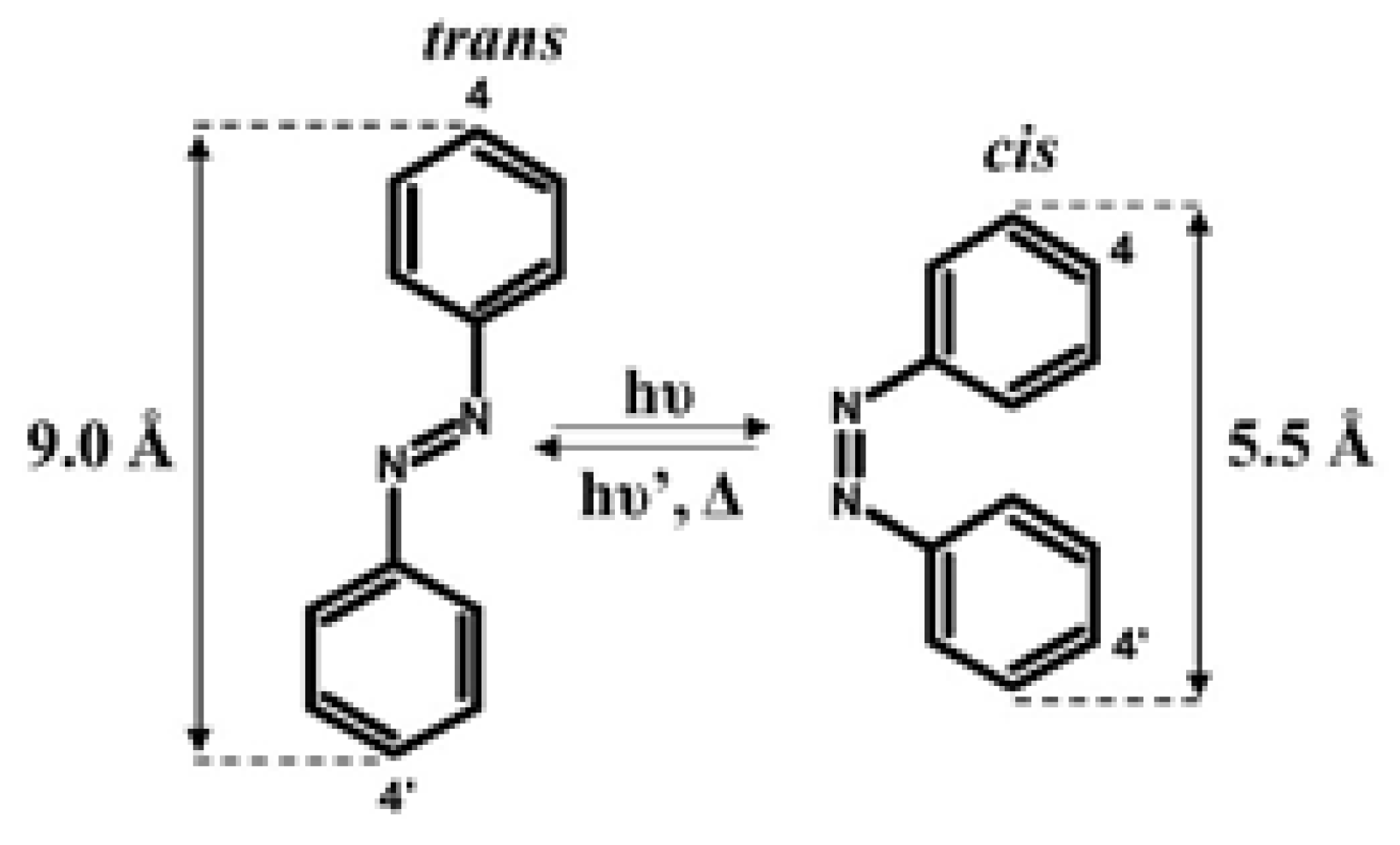
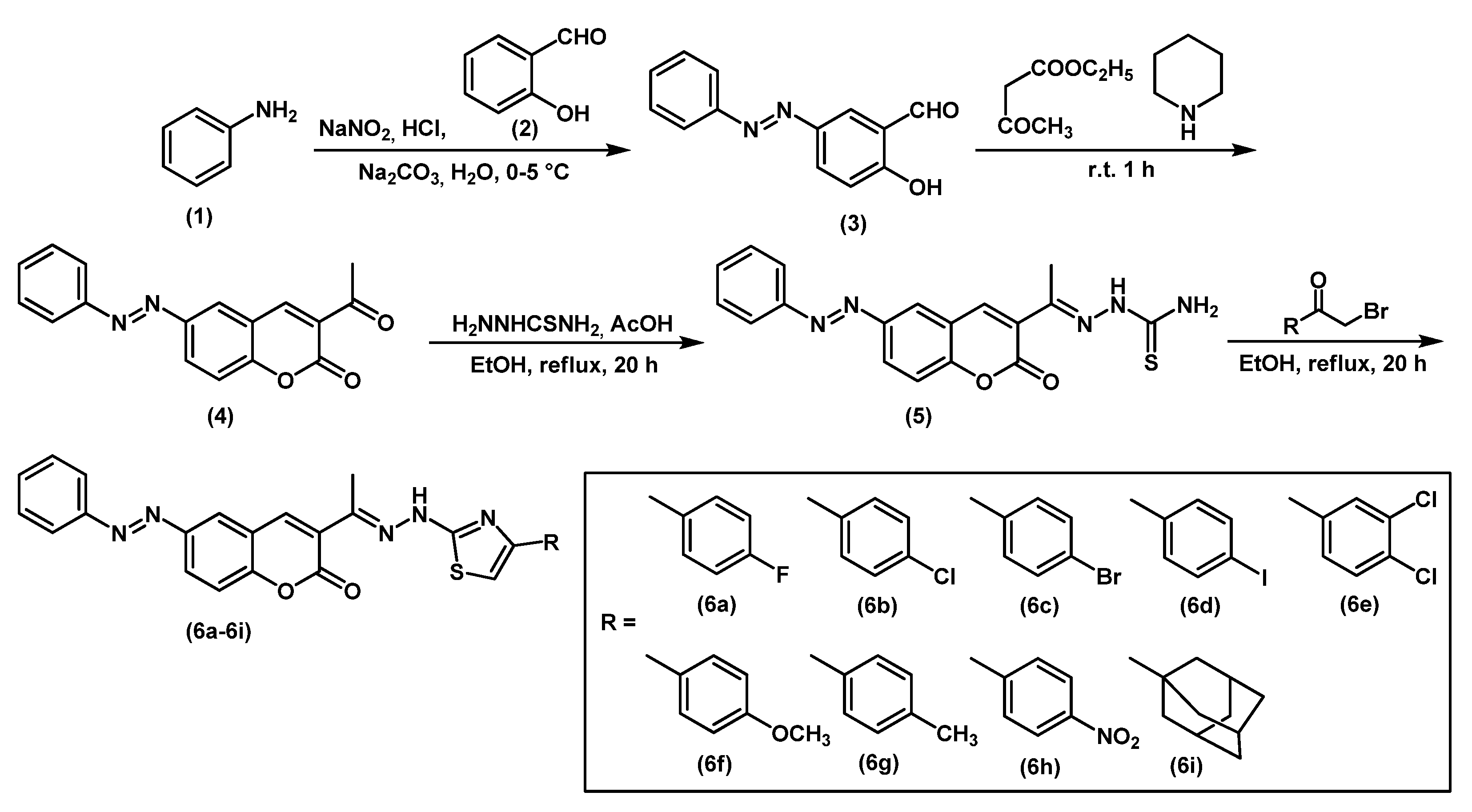
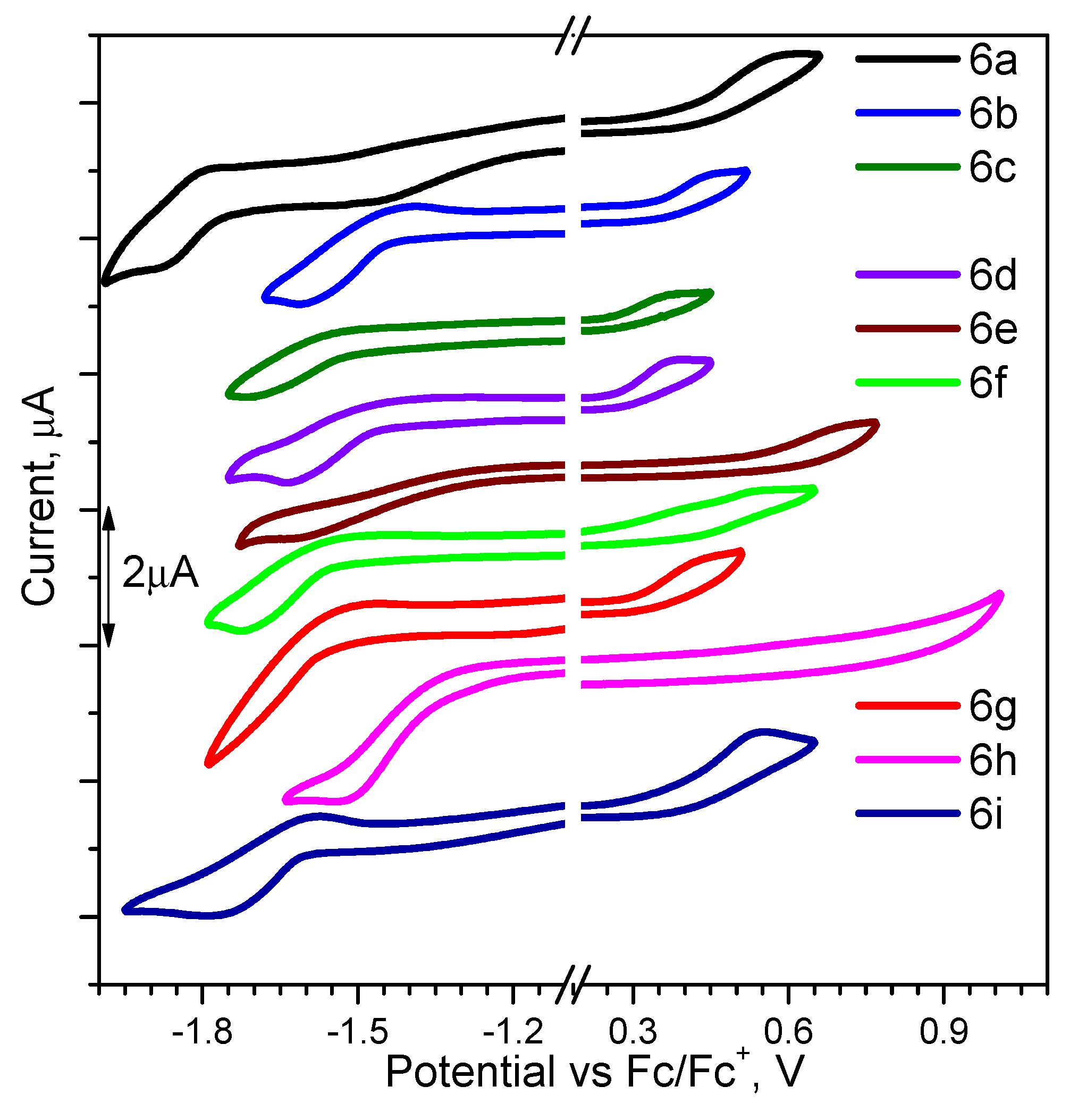
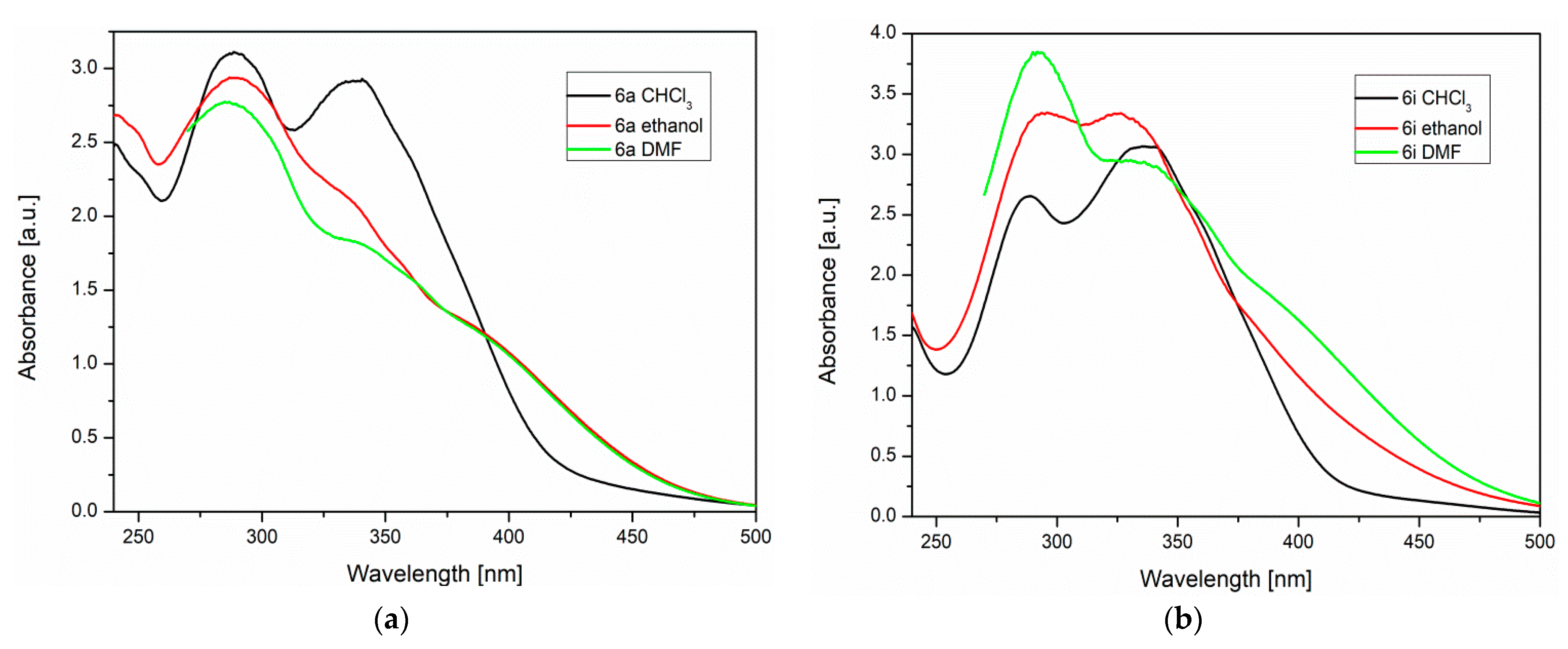
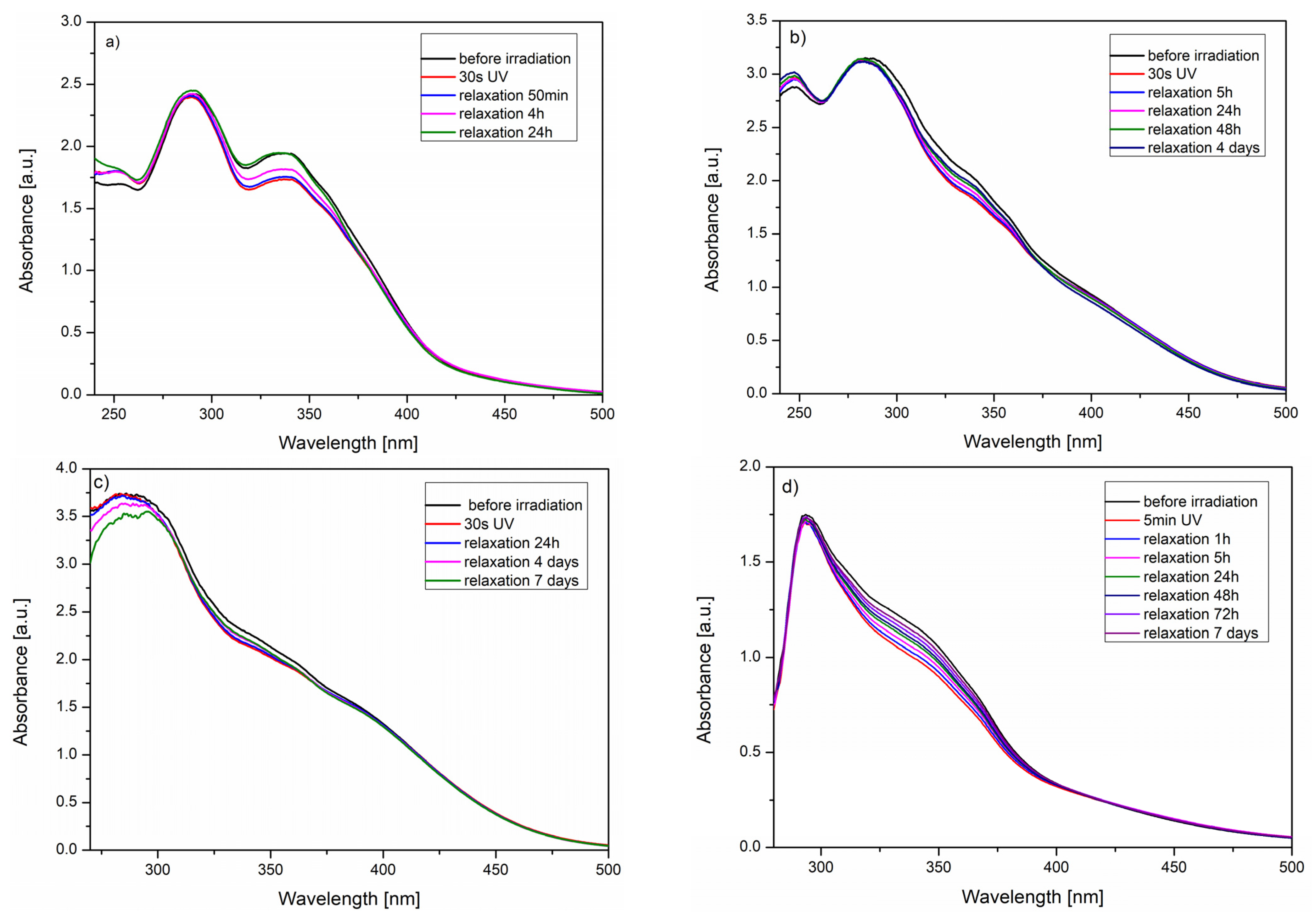

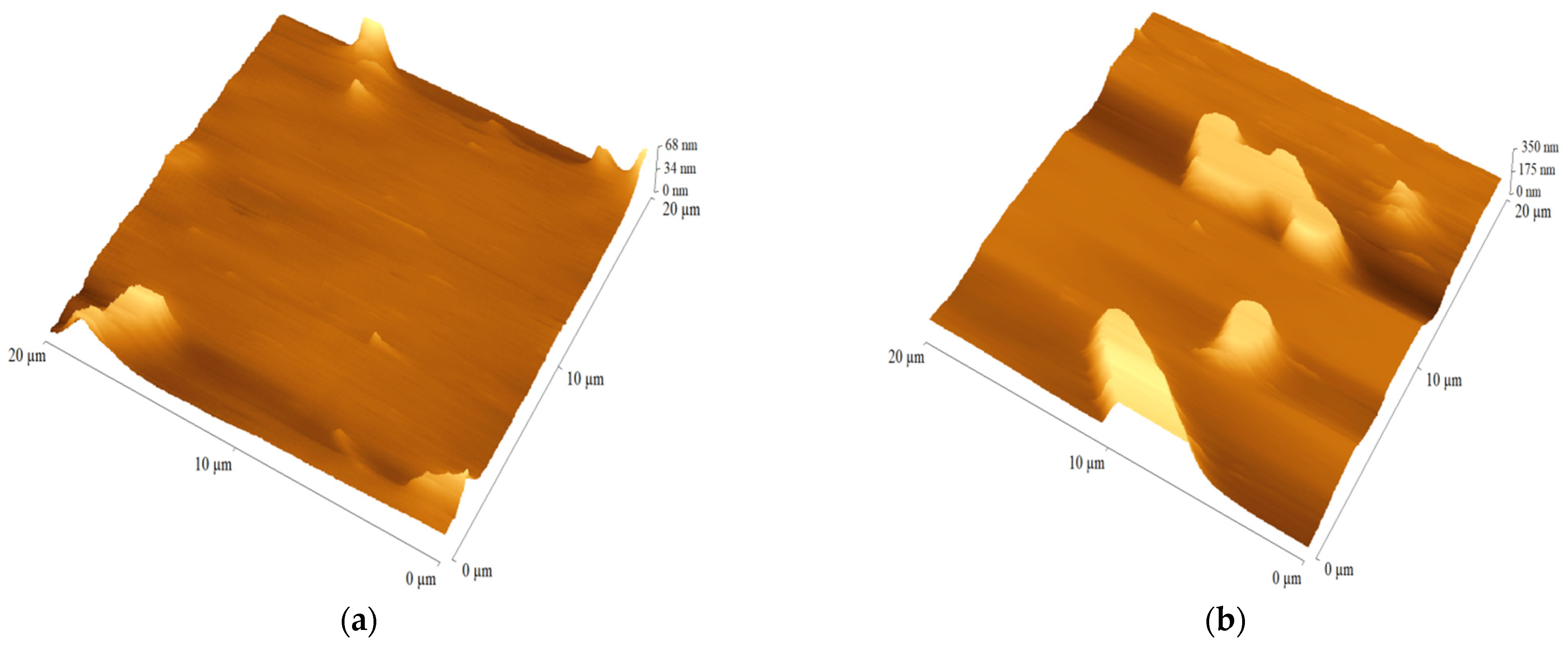
| Code | Eoxonset [V] | Ered onset [V] | HOMO [eV] | LUMO [eV] | Eg CV [eV] | Eg OPT [eV] |
|---|---|---|---|---|---|---|
| 6a | 0.38 | −1.75 | −5.48 | −3.35 | 2.13 | 2.40 |
| 6b | 0.33 | −1.42 | −5.43 | −3.68 | 1.75 | 2.36 |
| 6c | 0.25 | −1.48 | −5.35 | −3.62 | 1.73 | 2.20 |
| 6d | 0.25 | −1.46 | −5.35 | −3.64 | 1.71 | 2.22 |
| 6e | 0.51 | −1.31 | −5.61 | −3.79 | 1.82 | 2.34 |
| 6f | 0.19 | −1.52 | −5.29 | −3.58 | 1.71 | 2.20 |
| 6g | 0.31 | −1.53 | −5.41 | −3.57 | 1.84 | 2.22 |
| 6h | − | −1.32 | − | −3.79 | − | 2.44 |
| 6i | 0.35 | −1.60 | −5.45 | −3.50 | 1.95 | 2.18 |
| HOMO = −5.1 – Eox onset. LUMO = −5.1 − Ered onset, Eg CV = E ox onset – E red onset, Eg OPT = 1240/λ | ||||||
| Code | Solvent | |||||
|---|---|---|---|---|---|---|
| CHCl3 | C2H5OH | DMF | ||||
| λmax [nm] | ε [dm3mol−1cm−1] | λmax [nm] | ε [dm3mol−1cm−1] | λmax [nm] | ε [dm3mol−1cm−1] | |
| 6a | 290 337 | 29,999 29,392 | 289 | 29,400 | 285 | 27,700 |
| 6b | 291 338 | 24,200 19,450 | 284 | 31,500 | 286 | 37,400 |
| 6c | 292 335 | 30,475 23,718 | 292 | 33,600 | 282 | 38,900 |
| 6d | 294 334 | 30,900 21,700 | 288 | 37,700 | 283 | 36,700 |
| 6e | 293 340 | 32,800 21,500 | –* | –* | 288 | 38,100 |
| 6f | 293 330 | 39,250 30,800 | 281 | 38,150 | 281 | 35,016 |
| 6g | 290 340 | 32,500 27,100 | 248 288 | 33,000 36,700 | 283 | 13,100 |
| 6h | 296 344 | 31,684 28,185 | –* | –* | 298 346 | 15,600 12,000 |
| 6i | 289 336 | 26,500 30,700 | 296 326 | 33,450 33,400 | 292 336 | 38,500 29,400 |
| Code | Solvent | ||||||||
|---|---|---|---|---|---|---|---|---|---|
| CHCl3 | C2H5OH | DMF | |||||||
| Isosbestic Points [nm] | Content of cis Isomer (%) | Time of cis-trans Conversion [h] | Isosbestic Points [nm] | Content of cis Isomer (%) | Time of cis-trans Conversion [days] | Isosbestic Points [nm] | Content of cis Isomer (%) | Time of cis-trans Conversion [Days] | |
| 6a | 285; 416 | 16 | 24 | 291; 420 | 13.5 | >>4 | 282; 428 | 8 | >7 |
| 6b | 286; 415 | 11 | 25 | 275; 418 | 10 | >4 | 423 | 6 | >7 |
| 6c | 286; 417 | 16 | 29 | 279; 421 | 11.5 | >>4 | 286; 426 | 7 | >7 |
| 6d | 286; 421 | 15 | 28 | 278; 418 | 10 | 4 | 279; 430 | 7 | >7 |
| 6e | 279; 432 | 13 | >>24 | –* | –* | –* | 281; 416 | 9 | >>7 |
| 6f | 286; 414 | 22 | >>27 | 281; 425 | 10 | >>4 | 281; 428 | 8 | >7 |
| 6g | 287; 421 | 14 | 24 | 279; 434 | 10 | >>4 | 283; 425 | 11 | >7 |
| 6h | 286; 419 | 7 | 24 | –* | –* | –* | 282; 419 | 6.5 | >7 |
| 6i | 285; 415 | 14 | 24 | 292; 394 | 13 | >>4 | 282; 420 | 7 | >7 |
| Solar Cell Architecture | VOC [mV] | JSC [mA/cm2] | FF | PCE [%] | RSH [kΩ] | RS [kΩ] |
|---|---|---|---|---|---|---|
| ITO/PEDOT:PSS/6a:PC70BM/Al | no activity detected | 1.15 ± 0.69 | 1.31 ± 0.90 | |||
| ITO/PEDOT:PSS/6b:PC70BM/Al | 381 ± 58 | 0.53 ± 0.05 | 0.32 ± 0.02 | 0.07 ± 0.02 | 24.71 ± 14.62 | 8.73 ± 0.73 |
| ITO/PEDOT:PSS/6c:PC70BM/Al | 303 ± 70 | 0.44 ± 0.04 | 0.32 ± 0.02 | 0.05 ± 0.01 | 16.29 ± 5.59 | 8.67 ± 0.94 |
| ITO/PEDOT:PSS/6d:PC70BM/Al | 375 ± 39 | 0.61 ± 0.00 | 0.34 ± 0.02 | 0.08 ± 0.01 | 22.67 ± 0.81 | 6.11 ± 0.42 |
| ITO/PEDOT:PSS/6e:PC70BM/Al | no activity detected | 10.53 ± 2.59 | 12.07 ± 2.54 | |||
| ITO/PEDOT:PSS/6f:PC70BM/Al | 367 ± 71 | 0.47 ± 0.04 | 0.35 ± 0.03 | 0.07 ± 0.02 | 26.96 ± 11.52 | 7.38 ± 0.98 |
| ITO/PEDOT:PSS/6g:PC70BM/Al | 420 ± 87 | 0.63 ± 0.06 | 0.34 ± 0.03 | 0.10 ± 0.03 | 24.63 ± 10.17 | 6.23 ± 1.69 |
| ITO/PEDOT:PSS/6h:PC70BM/Al | 496 ± 85 | 0.43 ± 0.03 | 0.32 ± 0.02 | 0.07 ± 0.02 | 37.77 ± 7.81 | 10.89 ± 2.51 |
| ITO/PEDOT:PSS/6i:PC70BM/Al | no activity detected | 7.67 ± 2.90 | 9.10 ± 2.67 | |||
| ITO/PEDOT:PSS/PTB7:PC70BM:6g/PFN/Al (4:8:1) | 611 ± 8 | 7.16 ± 0.70 | 0.45 ± 0.01 | 2.01 ± 0.24 | 6.39 ± 1.75 | 0.54 ± 0.03 |
| ITO/PEDOT:PSS/PTB7:PC70BM:6g/PFN/Al (13:8:1) | 634 ± 7 | 10.80 ± 0.50 | 0.38 ± 0.02 | 2.68 ± 0.11 | 2.98 ± 0.59 | 0.58 ± 0.04 |
Publisher’s Note: MDPI stays neutral with regard to jurisdictional claims in published maps and institutional affiliations. |
© 2022 by the authors. Licensee MDPI, Basel, Switzerland. This article is an open access article distributed under the terms and conditions of the Creative Commons Attribution (CC BY) license (https://creativecommons.org/licenses/by/4.0/).
Share and Cite
Piechowska, K.; Baranowska-Łączkowska, A.; Łączkowski, K.Z.; Konieczkowska, J.; Siwy, M.; Vasylieva, M.; Gnida, P.; Nitschke, P.; Schab-Balcerzak, E. Novel Azocoumarin Derivatives—Synthesis and Characterization. Int. J. Mol. Sci. 2022, 23, 5767. https://doi.org/10.3390/ijms23105767
Piechowska K, Baranowska-Łączkowska A, Łączkowski KZ, Konieczkowska J, Siwy M, Vasylieva M, Gnida P, Nitschke P, Schab-Balcerzak E. Novel Azocoumarin Derivatives—Synthesis and Characterization. International Journal of Molecular Sciences. 2022; 23(10):5767. https://doi.org/10.3390/ijms23105767
Chicago/Turabian StylePiechowska, Katarzyna, Angelika Baranowska-Łączkowska, Krzysztof Z. Łączkowski, Jolanta Konieczkowska, Mariola Siwy, Marharyta Vasylieva, Paweł Gnida, Paweł Nitschke, and Ewa Schab-Balcerzak. 2022. "Novel Azocoumarin Derivatives—Synthesis and Characterization" International Journal of Molecular Sciences 23, no. 10: 5767. https://doi.org/10.3390/ijms23105767
APA StylePiechowska, K., Baranowska-Łączkowska, A., Łączkowski, K. Z., Konieczkowska, J., Siwy, M., Vasylieva, M., Gnida, P., Nitschke, P., & Schab-Balcerzak, E. (2022). Novel Azocoumarin Derivatives—Synthesis and Characterization. International Journal of Molecular Sciences, 23(10), 5767. https://doi.org/10.3390/ijms23105767






